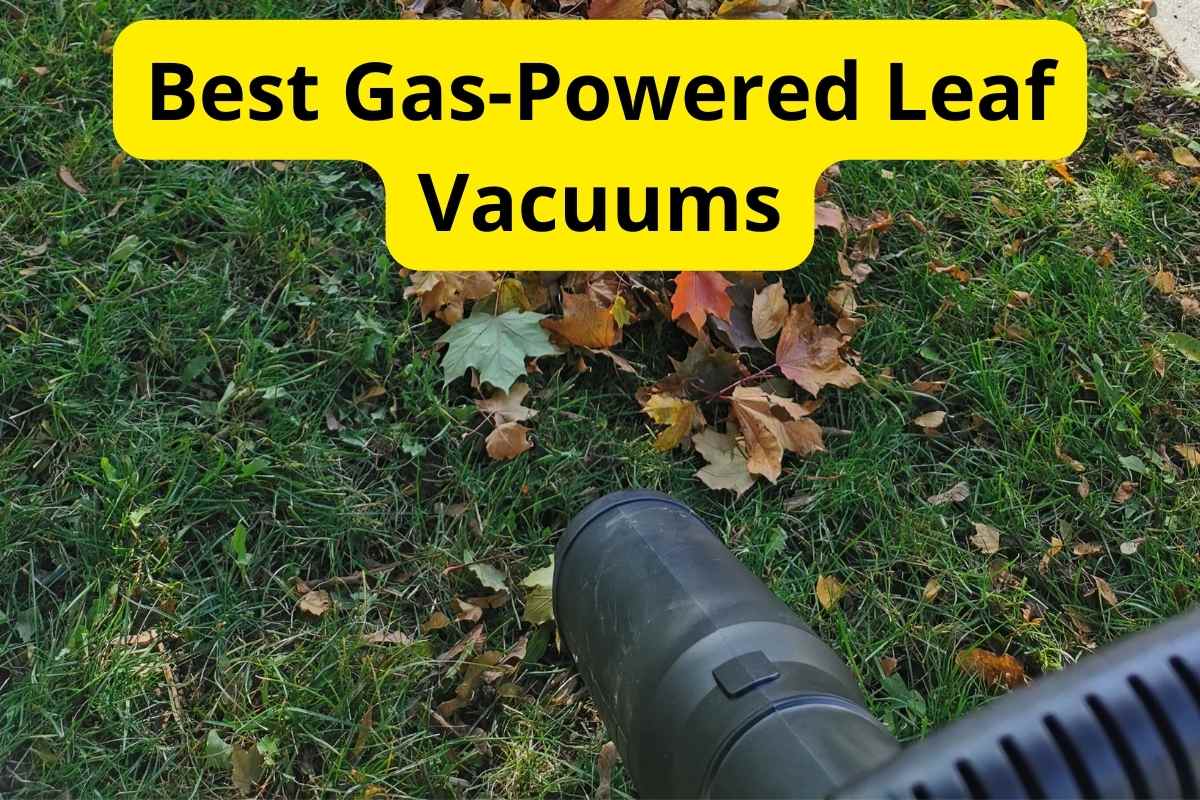
A gas-powered leaf vacuum makes leaf removal and other yard work a breeze, but which gas-powered leaf vacuum is right for you? We removed the guesswork by searching Home Depot, Lowe’s, Amazon, and Walmart for the best gas-powered leaf vacuums. We ranked each vacuum by performance, mulch ratio, comfort, and cost.
These five gas-powered leaf vacuums made the cut for our list of top products. Also, check out our buyer’s guide below to help you decide which gas-powered leaf vacuum is best for your yard.
Our Top Picks
| 5 Best Gas-Powered Leaf Vacuums |
| 1. Craftsman BV245 |
| 2. Troy-Bilt TB27VH |
| 3. Poulan Pro PPBV25 |
| 4. Echo ES-250AA |
| 5. SENIX BLV4QL-M |
Top 5 Gas-Powered Leaf Vacuums – Reviews
1. Craftsman BV245
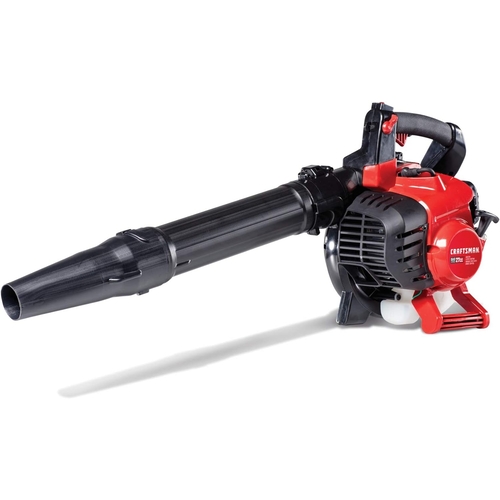
Craftsman BV245
High-Performance 27cc Gas Blower: 450 CFM/205 mph power, Vacuum Kit with 1.5-Bushel Bag, Easy Start, User-Friendly Design, and Engine Oil Included.
Our favorite gas-powered leaf vacuum is the Craftsman BV245. It’s powerful and versatile, making it great for large yards with many trees. Homeowners with heavy-duty cleanup will appreciate its time-saving features, including:
- 3 power tools in 1: It’s a powerful leaf blower that comes with a vac kit and mulches 16 bags of leaves down to one bag of mulch.
- Potent engine: It has a 27-cc, 2-cycle, full-crank gas engine that is powerful and efficient.
- Variable speed: The operator controls airflow with variable speed throttle and cruise control.
- Large collection bag: It has a 1.5-bushel bag, so you don’t have to keep stopping to dispose of debris.
- Ergonomic design: It’s lightweight, well-balanced, and has a vibration-reducing over-mold handle.
Overall, the Craftsman BV245 works well and is comfortable, so homeowners can quickly take care of fall leaves. It can blow wet leaves, dry leaves, pine straw, and even an occasional pine cone.
Specifications
- Air volume: 450 CFM
- Airspeed: 205 MPH
- Engine: 27-cc, 2-cycle
- Fuel tank capacity: 14 fl. oz.
- Mulch ratio: 16:1
- Noise level: 74 dB
- Weight: 10.2 lb.
Pros and Cons
| What we liked | What we didn’t like |
| ✓ Good air volume ✓ Fast air speed ✓ Handles heavy debris ✓ Comfortable ✓ Easy to use | ✗ Need a screwdriver to attach the vacuum tube |
2. Troy-Bilt TB27VH
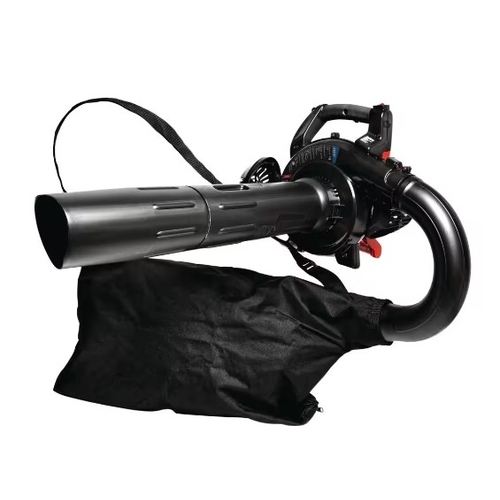
Troy-Bilt TB27VH
The Troy-Bilt TB27VH Gas Leaf Blower/Vac: 27cc engine, 450 CFM/205 MPH, easy start, variable speed, vacuum kit, 2-year warranty.
Another excellent tool for handling heavy-duty yard clean-up is the Troy-Bilt TB27VH. This handheld leaf blower comes with a vacuum/mulcher kit and packs a mighty punch with its well-balanced full-crank engine. It’s efficient, easy to handle, and costs slightly less than the Craftsman BV245.
Additionally, it has many helpful features, including:
- Large 1.5-bushel collection bag
- SpringAssist Starting for an easier pull start
- Additional curved tube that reaches around corners
- Variable speed with cruise control
Whether you’re leaf-blowing or using vacuum mode, the TB27VH is potent and easy to use, making it one of the best gas-powered leaf vacuums.
Specifications
- Air volume: 450 CFM
- Airspeed: 205 MPH
- Engine: 27-cc, 2-cycle
- Fuel tank capacity: 14 fl. oz.
- Mulch ratio: 16:1
- Noise level: 74 dB
- Weight: 10 lb.
Pros and Cons
| What we liked | What we didn’t like |
| ✓ Good air volume ✓ Fast air speed ✓ Mulches wet leaves ✓ Multiple tubes included | ✗ Single-handle design is sometimes difficult to maneuver due to the tool’s width |
3. Poulan Pro PPBV25
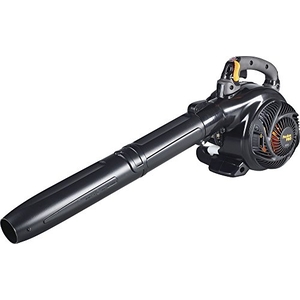
Poulan Pro PPBV25
Powerful 450 CFM Blower: Speeds up to 230 MPH, Soft-Grip Handle for Comfort, Includes Vacuum with 16:1 Mulch Ratio, Reduced Vibration.
If you want the most bang for your buck, consider the Poulan Pro PPBV25. It’s a meagerly priced handheld leaf blower with a vacuum kit. Although it’s the lowest-priced product on our list, it also has the fastest airspeed, maxing out at 230 MPH.
Blowing wet leaves and pine needles is effortless with this heavy-duty machine empowered by a 25-cc 2-cycle engine and a fuel-enriched carburetor. Its additional perks include:
- Soft-grip handle
- Vibration-reducing technology
- Variable speed trigger with cruise control
However, it’s also the heaviest tool on our list, so smaller operators may have difficulty using it for extended periods.
Specifications
- Air volume: 450 CFM
- Airspeed: 230 MPH
- Engine: 25-cc, 2-cycle
- Fuel tank capacity: 16.9 fl. oz.
- Mulch ratio: 16:1
- Noise level: 94 dB
- Weight: 17 lb.
Pros and Cons
| What we liked | What we didn’t like |
| ✓ Good air volume ✓ Fast air speed ✓ Affordable ✓ Handles heavy debris | ✗ Loud ✗ Heavy ✗ Difficult to switch between blower and vacuum mode |
4. Echo ES-250AA
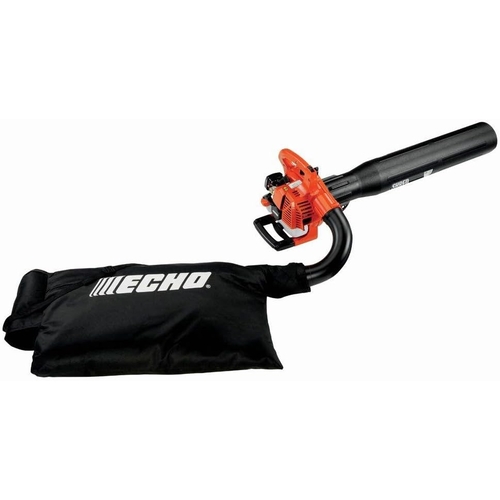
Echo ES-250AA
3-in-1 blower/vacuum/shredder with 12:1 debris reduction, powerful 25.4cc 2-stroke engine, and included collection bag.
The Echo ES-250AA Shred N Vac is a high-quality 3-in-1 tool that blows, vacuums, and shreds leaves. It saves you time by easily converting between vacuum and blower modes and including an extra-large 2-bushel collection bag. Additionally, it has an ergonomic design that reduces stress and fatigue.
Its features include:
- Professional-grade engine: Its high-performance engine is durable and efficient.
- Ergonomic tubes: It has a long (35-inch) intake tube and a curved blower tube to reduce fatigue and increase comfort.
- Electric ignition: Its Pro-Fire electronic ignition reduces vibration and makes the tool super simple to start.
- Variable speeds: It has a variable speed throttle with cruise control.
Although it has less air power than the other tools on our list, it compensates with ease of use, comfort, and durability. It’s an excellent leaf vacuum for homeowners with medium or small yards.
Specifications
- Air volume: 391 CFM
- Airspeed: 165 MPH
- Engine: 25.4-cc, 2-cycle
- Fuel tank capacity: 16.9 fl. oz.
- Mulch ratio: 12:1
- Noise level: 70 dB
- Weight: 12.6 lb.
Pros and Cons
| What we liked | What we didn’t like |
| ✓ Ergonomic ✓ Easy to start ✓ Durable ✓ Professional-grade engine | ✗ Not as potent as others on our list ✗ Doesn’t mulch as finely as others on our list |
5. SENIX BLV4QL-M
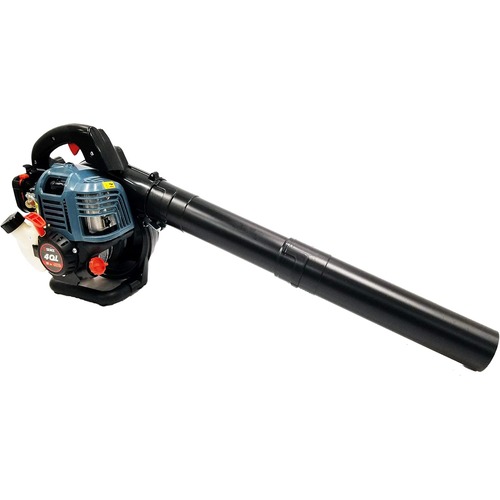
SENIX BLV4QL-M
Powerful 550 CFM/127 MPH, low-emission engine, mulcher capability, lightweight design. Includes collection bag and 3-year warranty.
The SENIX BLV4QL-M is a handheld leaf blower/vac with a 31-cc 4-cycle engine. Although 4-cycle engines tend to weigh more, they emit less emissions than 2-cycle engines because they have a separate lubrication system. This also means you won’t have to mix oil with gas. Additionally, the engine may run slower than comparable 2-cycle engines but can reach higher torque.
The BLV4QL-M doesn’t blow pine needles and wet leaves as other models on our list, but it can suck up large amounts of dry leaves at once. It also includes the following features:
- Compact design
- 1.4 bushel collection bag
- Included spark plug wrench
- Dual grip handle
You also have peace of mind with this machine because a 3-year consumer warranty covers it. It’s an excellent option for homeowners who want to reduce their carbon footprint while enjoying gas-powered potency.
Specifications
- Air volume: 550 CFM
- Airspeed: 127 MPH
- Engine: 31-cc, 4-cycle
- Fuel tank capacity: 9.47 fl. oz.
- Mulch ratio: 10:1
- Noise level: 69 dB
- Weight: 14 lb.
Pros and Cons
| What we liked | What we didn’t like |
| ✓ High air volume ✓ Don’t have to mix gas with oil ✓ Lower emissions than 2-cycle engines ✓ Fuel-efficient ✓ Easy to use | ✗ Heavy ✗ High-maintenance ✗ Doesn’t blow heavy debris ✗ Doesn’t mulch as finely as others on our list |
Buyer’s Guide
Need to narrow down your decision before buying a gas-powered leaf vacuum? The buyer’s guide below should help you evaluate your needs and choose the best leaf vacuum for you and your yard.
Let’s get started by defining a few key leaf vacuum terms regarding:
Power Source
A leaf vacuum’s power source may be a big factor in your choice. The three primary power sources are gas, corded electric, and battery. Each of these power sources is likely to meet your needs differently. The question to ask yourself is, which of your needs is a priority?
Gas-powered
You just read about five of the best-performing gas-powered leaf blower vacuums on the market. Gas-powered leaf vacuums have significant advantages, though they also come with some drawbacks.
Gas-powered models’ advantages include:
- Performance: They typically have more wind power than corded or battery-powered models, so the best gas leaf blowers with vacuum attachments pack a mighty punch! But keep in mind that some corded and battery models perform just as well as many gas leaf vacuums.
- Convenience: With no extension cords to hold them back, gas leaf blowers and vacuums are more mobile and easier for you to use. Some gas models even feature cruise control.
The disadvantages of gas-powered leaf vacuums:
- High-maintenance: Gas-powered tools usually require more maintenance than a corded or battery tool.
- Loud: Gas leaf vacuums also make lots of noise. On average, they are about 8 dB louder than battery vacuums and 14 dB louder than corded electric models.
- Harsh fumes: They smell like gasoline and emit exhaust fumes harmful to you (the user) and the environment.
Corded Electric
Corded electric tools have many advantages, including:
- Eco-Friendly: Corded electric leaf blower vacuums are an eco-friendly alternative to gas-powered models. All you need is an outlet and extension cord, and you can get to work –– no more having to pause the job to refill the gas tank.
- Lightweight design: Corded models also tend to weigh less than gas- and battery-powered tools because they don’t require a fuel tank or rechargeable battery.
- Runtime: They also offer an unlimited runtime, which is a top priority for some users.
- Cost: Corded electric models tend to be the most affordable. The average corded vacuum costs about $200 less than the average cordless leaf vacuum and about $150 less than the average gas vacuum. And some of the best leaf blower vacuums are corded electric models.
But they also have their disadvantages:
- Keep you on a leash: Perhaps the most significant disadvantage of corded electric leaf vacuums is the lack of user mobility. Despite the unlimited runtimes, operators must work near an outlet and are bound to the extension cord’s length.
Battery-powered
Most battery-powered leaf vacuums run on lithium-ion batteries, and their advantages include:
- Eco-friendly: They don’t emit harsh fumes.
- Convenience: Users needn’t worry about the high-maintenance hassle that comes with gas leaf vacuums and the limiting extension cords of corded models.
And their disadvantages are:
- Runtime: Opting for a battery-powered leaf vacuum means missing out on the unlimited runtime often associated with corded models. Once the battery runs out of juice, it’s time to stop the task at hand and grab the charger.
- Weight: Cordless blower vacuums will also typically weigh more than corded models because of the added battery weight.
Performance: Although gas-powered tools are typically more potent than battery-powered models, the best cordless electric leaf vacuums (i.e., Ryobi RY404150) and the best cordless leaf blowers (i.e., EGO Power+ LB6504) can compete with gas-powered products.
MPH and CFM
As you shop around for your new leaf vacuum, expect to see the measurements MPH and CFM. These numbers will help you evaluate the leaf vacuum’s performance.
What is MPH?
MPH is short for miles per hour. A leaf blower vacuum’s MPH measures how fast the air is moving. If a leaf vacuum has 200 MPH, that means the air that’s blowing or vacuuming up the leaves is moving at a speed of 200 miles per hour.
What is CFM?
CFM is short for cubic feet per minute. A leaf blower vacuum’s CFM measures how much air is moving per minute. If a leaf vacuum has a 450 CFM, that means an air volume of 450 cubic feet is blowing or vacuuming up the leaves per minute.
Which is more important, MPH or CFM?
Both measurements are important, not just one. Some buyers might be impressed with a high MPH, even if it’s matched with a relatively low CFM. But don’t let that exceptionally high MPH fool you, especially since it stands alone.
Here’s why: If a leaf vacuum has an exceptionally high MPH and low CFM, the lack of CFM will have a significant negative impact on the leaf vacuum’s power. Remember, CFM measures air volume. A small amount of fast-moving air won’t do much to a pile of leaves.
The Bottom Line
MPH measures airspeed, and CFM measures air volume. If air power is a priority, you’ll want to shop for a leaf vacuum that has high measurements for both MPH and CFM.
Typical CFM and MPH for Gas Leaf Vacuums
| Average air volume for gas vacuums | 415 CFM |
| Typical air volume range | 200 – 550 CFM |
| Average airspeed for gas vacuums | 180 MPH |
| Typical airspeed range | 130 – 230 MPH |
Mulch Reduction Ratio
A mulch reduction ratio measures how well the leaf vacuum’s mulcher shreds debris. If a leaf vacuum has a mulch reduction ratio of 16:1, that means the mulch shredder can reduce up to 16 bags of leaves down to 1 bag of mulch.
A high mulch reduction ratio might prove helpful if you have a lot of leaves to bag. Don’t send those bags of leaves to the landfill; put the bag of mulched leaves in your garden or flower beds.
| Average mulch ratio for gas leaf vacuums | 14:1 |
| Typical range for gas leaf vacuums | 10:1 – 16:1 |
Versatility
Most leaf vacuums have a 3-in-1 design that includes a leaf blower, leaf vacuum, and mulcher. A versatile design is useful for buyers shopping on a budget or who have limited storage space in the garage.
Weight
A leaf vacuum’s weight is an important factor in your decision-making. For example, after an afternoon in the hot sun, you’ll be glad you bought the leaf vacuum that weighs less than other models.
Lightweight leaf vacuum designs help prevent muscle fatigue/strain and even help increase productivity — the heavier the tool, the more breaks you likely will need to take.
| Average weight of gas leaf vacuums | 12 lb. |
| Typical range for gas leaf vacuums | 9 – 15 lb. |
Noise Level
Don’t expect blowing and vacuuming up those leaves to be a quiet task. Before buying your leaf vacuum, make sure its decibel rating (dBA) is appropriate for your area’s laws. Many counties and cities have local ordinances to limit noise pollution.
| Average noise level of gas leaf vacuums | 77 dB |
| Typical range for gas leaf vacuums | 70 – 90 dB |
| Average noise level of all leaf vacuums | 68 dB |
| Typical range for all leaf vacuums | 60 – 75 dB |
Bag Size
Leaf vacuums come equipped with a leaf-collecting bag measured in gallons or bushels. Bag sizes typically range from 0.5 to 2 bushels and affect how often you will need to pause your work to empty the bag.
If you find starting and stopping your work to be a nuisance, the best leaf blower vacuum for you may be one with a large leaf-collecting bag.
FAQ About Gas-Powered Leaf Vacuums
1. Why get a handheld leaf vacuum, not a mower leaf vacuum?
Turning an existing lawn mower into an effective leaf vacuum is not a bad idea, but there are some things a handheld leaf vacuum can do that a mower leaf vacuum can’t.
Here are a few reasons you might want a handheld leaf blower vacuum:
- It can vacuum fallen leaves on hard surfaces, such as the deck, garage, or porch. A mower leaf vacuum can only suck up leaves in the grass.
- It can suck up the leaves near the sides of fences, corners, and other tight spaces a mower leaf vacuum fails to reach.
- You can use it indoors. A mower leaf vacuum won’t do much good indoors.
2. How do I get leaves off my gravel?
Are leaves falling on your gravel driveway or river rock walkway? That’s easy to take care of.
The No. 1 rule? Don’t suck up the rocks.
Leaves weigh less than rocks. As long as you have your leaf vacuum on a low power setting, it should be strong enough to pick up the leaves while leaving the stones alone.
If your leaf vacuum begins to suck up the rocks, stop vacuuming the area right away. You may need to lower the power setting or consider buying a leaf vacuum that isn’t so strong.
3. What are the best backpack leaf blowers?
The best backpack leaf blowers are the Husqvarna 570BTS and the Echo PB-770T.
When to Call a Leaf Removal Pro
The best gas-powered leaf vacuums make yard cleanup more manageable, but the easiest way to remove leaves is to hire someone else to do it. LawnStarter connects you with local leaf removal pros who are qualified and affordable. After receiving a free quote, most customers are shocked to see what a low price they can get through LawnStarter.
In addition to leaf removal, our pros do over 30 outdoor home services, including lawn mowing, landscaping, and bush trimming. Keeping a clean yard, lush lawn, and flourishing garden beds has never been so simple.
LawnStarter participates in the Amazon Services LLC Associates Program and other retailer affiliate programs. LawnStarter may earn revenue from products promoted in this article.
Main Image Credit: Farell R / Canva Pro / License wih Text Overlay using Canva Pro
![9 Best Leaf Vacuums of 2025 [Reviews] leaf blower garden vacuum with text overlay on it](https://www.lawnstarter.com/blog/wp-content/uploads/2023/10/Best-Leaf-Vacuums.jpg)
![9 Best Leaf Blower Vacuums of 2025 [Reviews] Leaf Blower vacuum cleaning driveway with text overlay on it](https://www.lawnstarter.com/blog/wp-content/uploads/2023/10/Best-Leaf-Blower-vacuums.jpg)
![5 Best Cordless Leaf Vacuums of 2025 [Reviews] leaf vacuum cleaning leaves with text overlay on it](https://www.lawnstarter.com/blog/wp-content/uploads/2023/10/Best-Cordless-Leaf-Vacuum.jpg)
![10 Best Gas Leaf Blowers of 2025 [Reviews] worker cleaning leaves with a blower with text overlay on it](https://www.lawnstarter.com/blog/wp-content/uploads/2023/10/Best-Gas-Leaf-Blowers.jpg)
![10 Best Cordless Leaf Blowers of 2025 [Reviews] worker cleaning leaves with a blower with text overlay on it](https://www.lawnstarter.com/blog/wp-content/uploads/2021/07/Best-Cordless-Leaf-Blowers.jpg)